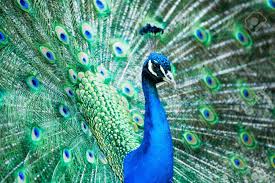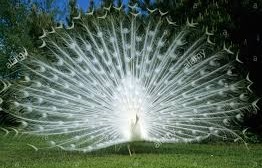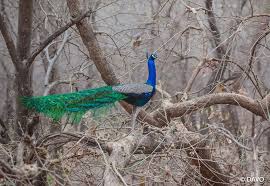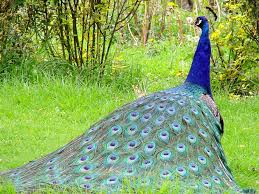The Indian peafowl or blue peafowl, a large and brightly coloured bird, is a species of peafowl native to
South Asia, but introduced in many other parts of the world.
The male peafowl is predominantly blue with a fan-like crest of spatula-tipped wire-like feathers and is best
known for the long train made up of elongated upper-tail covert feathers which bear colourful eyespots.
These stiff feathers are raised into a fan and quivered in a display during courtship. Females lack the
train, and have a greenish lower neck and duller brown plumage. The Indian peafowl lives mainly on the
ground in open forest or on land under cultivation where they forage for berries, grains but also prey on
snakes, lizards, and small rodents. Their loud calls make them easy to detect, and in forest areas often
indicate the presence of a predator such as a tiger. They forage on the ground in small groups and usually
try to escape on foot through undergrowth and avoid flying, though they fly into tall trees to roost.
The function of the peacock's elaborate train has been debated for over a century. In the 19th century,
Charles Darwin found it a puzzle, hard to explain through ordinary natural selection. His later explanation,
sexual selection, is widely but not universally accepted. In the 20th century, Amotz Zahavi argued that the
train was a handicap, and that males were honestly signalling their fitness in proportion to the splendour of
their trains. Despite extensive study, opinions remain divided on the mechanisms involved.
The bird is celebrated in Indian and Greek mythology and is the national bird of India. The Indian peafowl
is listed as of Least Concern by the International Union for Conservation of Nature (IUCN).
Description

Peacocks are a larger sized bird with a length from bill to tail of 100 to 115 cm (39 to 45 in) and to the
end of a fully grown train as much as 195 to 225 cm (77 to 89 in) and weigh 4-6 kg (8.8-13.2 lb). The
females, or peahens, are smaller at around 95 cm (37 in) in length and weigh 2.75-4 kg (6.1-8.8 lb). Indian
peafowl are among the largest and heaviest representatives of the Phasianidae. Their size, colour and shape
of crest make them unmistakable within their native distribution range. The male is metallic blue on the
crown, the feathers of the head being short and curled. The fan-shaped crest on the head is made of feathers
with bare black shafts and tipped with bluish-green webbing. A white stripe above the eye and a crescent
shaped white patch below the eye are formed by bare white skin. The sides of the head have iridescent
greenish blue feathers. The back has scaly bronze-green feathers with black and copper markings. The scapular
and the wings are buff and barred in black, the primaries are chestnut and the secondaries are black. The
tail is dark brown and the "train" is made up of elongated upper tail coverts (more than 200 feathers, the
actual tail has only 20 feathers) and nearly all of these feathers end with an elaborate eye-spot. A few of
the outer feathers lack the spot and end in a crescent shaped black tip. The underside is dark glossy green
shading into blackish under the tail. The thighs are buff coloured. The male has a spur on the leg above the
hind toe.
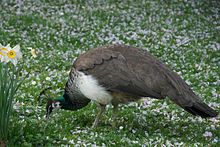
The adult peahen has a rufous-brown head with a crest as in the male but the tips are chestnut edged with
green. The upper body is brownish with pale mottling. The primaries, secondaries and tail are dark brown.
The lower neck is metallic green and the breast feathers are dark brown glossed with green. The remaining
underparts are whitish. Downy young are pale buff with a dark brown mark on the nape that connects with the
eyes. Young males look like the females but the wings are chestnut coloured.
The most common calls are a loud pia-ow or may-awe. The frequency of calling increases before the Monsoon
season and may be delivered in alarm or when disturbed by loud noises. In forests, their calls often indicate
the presence of a predators such as the tiger. They also make many other calls such as a rapid series of
ka-aan..ka-aan or a rapid kok-kok. They often emit an explosive low-pitched honk! when agitated.
Mutations and hybrids
A white peafowl that is maintained by selective breeding in many parks such as this one at the Jardin des
Plantes, Paris. This mutation is commonly mistaken for an albino.
There are several colour mutations of Indian peafowl. These very rarely occur in the wild, but selective
breeding has made them common in captivity. The black-shouldered or Japanned mutation was initially
considered as a subspecies P. c. nigripennis (or even a species), and was a topic of some interest during
Darwin's time. It is however only a case of genetic variation within the population. In this mutation, the
adult male is melanistic with black wings. Young birds with the nigripennis mutation are creamy white with
fulvous tipped wings. The gene produces melanism in the male and in the peahen it produces a dilution of
colour with creamy white and brown markings. Other variations include the pied and white forms all of which
are the result of allelic variation at specific loci.
Cross between a male green peafowl, Pavo muticus and a female Indian peafowl, P. cristatus, produces a stable
hybrid called a "spalding", named after Mrs. Keith Spalding, a bird fancier in California. There can be
problems if birds of unknown pedigree are released into the wild, as the viability of such hybrids and their
offspring is often reduced (see Haldane's Rule and outbreeding depression).
Distribution and habitat
The Indian peafowl is a resident breeder across the Indian subcontinent and is found in the drier lowland
areas of Sri Lanka. In South Asia, it is found mainly below an altitude of 1,800 metres (1.1 mi) and in rare
cases seen at about 2,000 metres (1.2 mi). It is found in moist and dry-deciduous forests, but can adapt to
live in cultivated regions and around human habitations and is usually found where water is available. In
many parts of northern India, they are protected by religious practices and will forage around villages and
towns for scraps. Some have suggested that the peacock was introduced into Europe by Alexander the Great,
while others say the bird had reached Athens by 450 BCE and may have been introduced even earlier. It has
since been introduced in many other parts of the world and has become feral in some areas.
Besides its native habitat, the bird has been introduced by humans to the United States, Mexico, Honduras,
Colombia, Guyana, Suriname, Brazil, Uruguay, Argentina, South Africa, Portugal, Madagascar, Mauritius,
Réunion, Indonesia, Papua New Guinea, Australia, Croatia (Split, island of Lokrum), and elsewhere. In
isolated cases, the Indian peafowl has been known to be able to adapt to harsher climates, such as those of
northern Canada. The species has been spotted as far north as Schomberg, Ontario, thriving in its newly
adapted northern climate.
Behavior and ecology
Peafowl are best known for the male's extravagant display feathers which, despite actually growing from their
back, are thought of as a tail. The "train" is in reality made up of the enormously elongated upper tail
coverts. The tail itself is brown and short as in the peahen. The colours result not from any green or blue
pigments but from the micro-structure of the feathers and the resulting optical phenomena. The long train
feathers (and tarsal spurs) of the male develop only after the second year of life. Fully developed trains
are found in birds older than four years. In northern India, these begin to develop each February and are
moulted at the end of August. The moult of the flight feathers may be spread out across the year.
Peafowl forage on the ground in small groups, known as musters, that usually have a cock and 3 to 5 hens.
After the breeding season, the flocks tend to be made up only of females and young. They are found in the
open early in the mornings and tend to stay in cover during the heat of the day. They are fond of
dust-bathing and at dusk, groups walk in single file to a favourite waterhole to drink. When disturbed, they
usually escape by running and rarely take to flight.
Peafowl produce loud calls especially in the breeding season. They may call at night when alarmed and
neighbouring birds may call in a relay like series. Nearly seven different call variants have been
identified in the peacocks apart from six alarm calls that are commonly produced by both sexes.
Peafowl roost in groups during the night on tall trees but may sometimes make use of rocks, buildings or
pylons. In the Gir forest, they chose tall trees in steep river banks. Birds arrive at dusk and call
frequently before taking their position on the roost trees. Due to this habit of congregating at the roost,
many population studies are made at these sites. The population structure is not well understood. In a study
in northern India (Jodhpur), the number of males was 170-210 for 100 females but a study involving evening
counts at the roost site in southern India (Injar) suggested a ratio of 47 males for 100 females.
Breeding
Peacocks are polygamous, and the breeding season is spread out but appears to be dependent on the rains.
Peafowls usually reach sexual maturity at the age of 2 to 3 years old. Several males may congregate at a
lek site and these males are often closely related. Males at lek appear to maintain small territories next
to each other and they allow females to visit them and make no attempt to guard harems. Females do not
appear to favour specific males. The males display in courtship by raising the upper-tail coverts into an
arched fan. The wings are held half open and drooped and it periodically vibrates the long feathers producing
a ruffling sound. The cock faces the hen initially and struts and prances around and sometimes turns around
to display the tail. Males may also freeze over food to invite a female in a form of courtship feeding. Males
may display even in the absence of females. When a male is displaying, females do not appear to show any
interest and usually continue their foraging. The peak season in southern India is April to May, January to
March in Sri Lanka and June in northern India. The nest is a shallow scrape in the ground lined with leaves,
sticks and other debris. Nests are sometimes placed on buildings and in earlier times have been recorded
using the disused nest platforms of the white-rumped vultures. The clutch consists of 4-8 fawn to buff white
eggs which are incubated only by the female. The eggs take about 28 days to hatch. The chicks are nidifugous
and follow the mother around after hatching. Downy young may sometimes climb on their mothers' back and the
female may carry them in flight to a safe tree branch. An unusual instance of a male incubating a clutch of
eggs has been reported.
Feeding
Peafowl are omnivorous and eat seeds, insects, fruits, small mammals and reptiles. They feed on small snakes
but keep their distance from larger ones. In the Gir forest of Gujarat, a large percentage of their food is
made up of the fallen berries of Zizyphus. Around cultivated areas, peafowl feed on a wide range of crops
such as groundnut, tomato, paddy, chili and even bananas. Around human habitations, they feed on a variety
of food scraps and even human excreta. In the countryside, it is particularly partial to crops and garden
plants.



